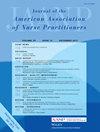To precept or not to precept: Perspectives from nurse practitioners.
IF 1.2
4区 医学
Journal of the American Association of Nurse Practitioners
Pub Date : 2024-09-10
DOI:10.1097/jxx.0000000000001071
引用次数: 0
Abstract
BACKGROUND Nurse practitioner (NP) preceptors are crucial to clinical education. Recent increases in the required direct patient care hours for NP students may worsen the current preceptor shortage. However, most studies of preceptorship only include NPs who are current preceptors and are therefore missing vital information from nonpreceptors. It is imperative to understand facilitators and barriers to preceptorship from the perspective of NPs who have stopped being or have never been preceptors. PURPOSE The purpose of this study was to understand the factors influencing NPs' decisions whether to precept. METHODOLOGY This was a descriptive, phenomenological study. Semistructured interviews were recorded in Zoom, transcribed verbatim, deidentified, and analyzed using thematic analysis. RESULTS Sixty NPs participated in the study: 23 current preceptors, 22 previous preceptors, and 15 who had never been preceptors. Facilitators to preceptorship included institutional support of preceptorship, positive student characteristics, clear expectations from the educational facility, and incentives. Barriers to preceptorship included time constraints, specialty, negative student characteristics, no institutional support, and being uncomfortable in the clinical role. CONCLUSIONS Preceptors and nonpreceptors shared similar themes-positive student characteristics and clear expectations as facilitators to preceptorship, and time as a barrier. However, other themes were unique to one preceptorship group. This provides new evidence for practice and research. IMPLICATIONS Nurse practitioner programs can facilitate preceptorship by ensuring that students are well prepared and providing clear expectations. Strategies should be developed to manage the time burden of preceptorship. In addition, support for preceptorship by health care organizations and systems should be studied.做戒律还是不做戒律?执业护士的观点。
背景护师(NP)戒护员对临床教育至关重要。最近对护师学生要求的直接病人护理时间的增加可能会加剧目前的戒护师短缺问题。然而,大多数关于戒护的研究只包括目前担任戒护师的护师,因此缺少非戒护师的重要信息。从已不再担任或从未担任过戒护员的护士的角度来了解戒护的促进因素和障碍是非常必要的。本研究的目的是了解影响护士决定是否担任戒护员的因素。半结构式访谈以中型录音机录制,逐字转录,去标识,并使用主题分析法进行分析。结果有 60 名 NP 参与了研究:23 名现任戒护者、22 名前任戒护者和 15 名从未担任过戒护者。实习指导的促进因素包括机构对实习指导的支持、学生的积极特点、教育机构的明确期望以及激励措施。接受实习指导的障碍包括时间限制、专业、学生的负面特点、没有机构支持以及在临床角色中感到不自在。然而,其他一些主题则是某一戒酒小组所独有的。这为实践和研究提供了新的证据。启示护士执业课程可以通过确保学生做好充分准备和提供明确的期望来促进实习前培训。应制定策略来管理实习的时间负担。此外,还应研究医疗机构和系统对实习前培训的支持。
本文章由计算机程序翻译,如有差异,请以英文原文为准。
求助全文
约1分钟内获得全文
求助全文
来源期刊

Journal of the American Association of Nurse Practitioners
Nursing-General Nursing
自引率
16.70%
发文量
172
期刊介绍:
The Journal of the American Association of Nurse Practitioners (JAANP) is a monthly peer-reviewed professional journal that serves as the official publication of the American Association of Nurse Practitioners.
Published since 1989, the JAANP provides a strong clinical focus with articles related to primary, secondary, and tertiary care, nurse practitioner education, health policy, ethics and ethical issues, and health care delivery. The journal publishes original research, integrative/comprehensive reviews, case studies, a variety of topics in clinical practice, and theory-based articles related to patient and professional education. Although the majority of nurse practitioners function in primary care, there is an increasing focus on the provision of care across all types of systems from acute to long-term care settings.
 求助内容:
求助内容: 应助结果提醒方式:
应助结果提醒方式:


